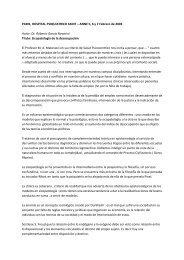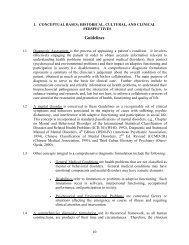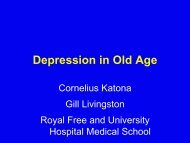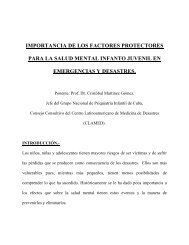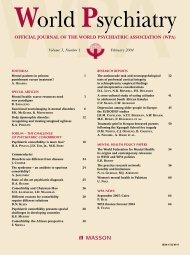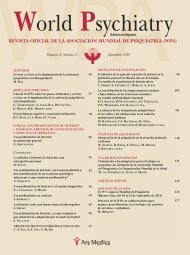ABSTRACTS - World Psychiatric Association
ABSTRACTS - World Psychiatric Association
ABSTRACTS - World Psychiatric Association
You also want an ePaper? Increase the reach of your titles
YUMPU automatically turns print PDFs into web optimized ePapers that Google loves.
SS15.<br />
PROCESSES OF INCLUSION FOR PEOPLE<br />
WITH INTELLECTUAL DISABILITY AND MENTAL<br />
HEALTH PROBLEMS<br />
(organized by the WPA Section on Psychiatry<br />
of Intellectual Disability)<br />
SS15.1.<br />
INTELLECTUAL DISABILITIES AND EUROPEAN<br />
PROGRAMS ON SOCIAL INCLUSION FOR MENTAL<br />
HEALTH<br />
L. Salvador-Carulla<br />
PSICOST Research <strong>Association</strong>, Jerez de la Frontera, Spain<br />
Social exclusion is a major public health risk that affects the mental<br />
health of a very large number of people across the European Union<br />
(EU). It can impede access to services and resources such as housing<br />
and employment. Solidarity and social cohesion are hallmarks of the<br />
European Union, as stated in the EU Green Paper on Mental Health<br />
in Europe and the Lisbon Conference. Recently, work in the EU has<br />
focused on developing methods to improve social inclusion of people<br />
with mental illness or at risk of mental illness. These programs are<br />
aimed at fostering recovery and promote the opening of opportunities<br />
in the community for people with psychiatric disorders, and to promote<br />
mental health and resiliency in this population. These programs<br />
do not adequately consider the problems of the persons with intellectual<br />
disabilities and mental health problems who may account for<br />
33% of all people with intellectual disabilities. The ongoing programs<br />
at the EU and their implications for intellectual disabilities are<br />
reviewed. The POMONA project, an EU project on health indicators<br />
of people with intellectual disabilities, is presented as an example.<br />
SS15.2.<br />
HOW SHOULD SERVICES RESPOND TO PEOPLE<br />
WITH INTELLECTUAL DISABILITIES WHO ARE<br />
SUSPECTED, CHARGED, OR CONVICTED<br />
OF A CRIMINAL OFFENCE<br />
T. Holland<br />
Department of Psychiatry, University of Cambridge, UK<br />
Challenging behaviour is common among people with intellectual<br />
disabilities (ID), and sometimes results in contact with the criminal<br />
justice agencies. In England, provisions are in place when people<br />
with ID are interviewed as suspects. Courts may seek guidance with<br />
respect to fitness to plead and, on issues relating mitigation and sentencing,<br />
if a person with ID is found guilty. Data are presented on the<br />
prevalence and nature of offending by people with ID and on the care<br />
pathways of people with ID in the criminal justice and/or health systems.<br />
Issues such as fitness to plead, vulnerability at police interview,<br />
and the ability to form intent, are considered. People with ID are<br />
over-represented in the criminal justice system, but whether the<br />
police are called in the event of challenging behaviour appears arbitrary.<br />
When diverted from the criminal justice system, people with ID<br />
can become trapped in distant secure settings for prolonged periods<br />
of time. In the UK, government policy has emphasised the importance<br />
of the diversion of people with mental disorder from the criminal<br />
justice system to receive treatment. This is problematic for people<br />
with ID, as the focus might more appropriately be on the management<br />
of risk in the community rather than treatment in hospital.<br />
SS15.3.<br />
FROM “THERAPEUTIC” SEGREGATION TO SOCIAL<br />
INTEGRATION<br />
E. Farnetani, M. Bertelli<br />
University of Siena; WORK 2000, Arezzo; Italian Society for<br />
the Study of Mental Retardation/Intellectual Disability, Italy<br />
When people with severe intellectual disabilities (ID) grow older and<br />
their family loses capacity to keep them at home, institutionalisation<br />
still represents the most frequent solution. Providing housing support<br />
is not the most difficult problem to address. Of greater concern is the<br />
availability of support service for the maintenance or the development<br />
of life skills. Thus, the disorder-unspecific approach of old asylum<br />
type institutions should give way to the individualised intervention of<br />
community centres. In the area of Valdichiana (Tuscany, Italy) the<br />
Work 2000 cooperative is putting into effect a programme of inclusion<br />
and quality of life (QoL) enhancement for people with ID through<br />
group homes integrated with the local mental health service net. The<br />
present study aims at evaluating the impact of this new intervention<br />
on the health care cost of the person with ID, on carers’ subjective<br />
burden of care, and on clients’ QoL. Cost includes any kind of health<br />
service (i.e., general practitioner or specialist visit, emergency, hospitalisation,<br />
nursing), drugs, and care. Preliminary results indicate a<br />
reduction of both general health care cost and carer’s burden of care,<br />
and an improvement of clients’ QoL. Flexible housing models of community<br />
integration seem to be usefully applicable to people with ID.<br />
SS15.4.<br />
A HOUSING SERVICE AS A THERAPEUTIC<br />
INSTRUMENT FOR PEOPLE WITH SEVERE<br />
INTELLECTUAL DISABILITY<br />
M. Bertelli, L. Lombardi, A. Paoli, I. Masciavè<br />
AMG Centre for Research and Evolution, Florence, Italy<br />
In the last decade, an international movement of deinstitutionalisation<br />
has developed, along with the worldwide cultural and scientific<br />
revision of the concept of mental retardation. The most innovative<br />
aspect is the consideration of the person in his wholeness, in his unitary<br />
development, and in reference to the life-span. There is no evidence<br />
that mental functions other from cognition are necessarily<br />
impaired in the intellectual disability (ID) person. It can be instead<br />
assumed that these functions may represent the fulcrum of the whole<br />
psychic functioning as well as an interface for the interaction with the<br />
environment. We describe the theoretical basis for the construction of<br />
a new rehabilitative environment for people with severe ID with or<br />
without mental health problems. Architecture should facilitate usability<br />
and identification by offering a wide range of logical, archetypal,<br />
emotional, or spiritual shapes. The environment should communicate<br />
a sense of continuity between inside and outside. It should offer<br />
a sense of protection and safety, but it should also transmit involvement<br />
with the external. Some spaces and rooms should be equipped<br />
for multi-sensorial stimulation. Walls and floors could be covered<br />
with different combinations of materials and developed like reflexologic<br />
tools to improve sense of balance.<br />
89




